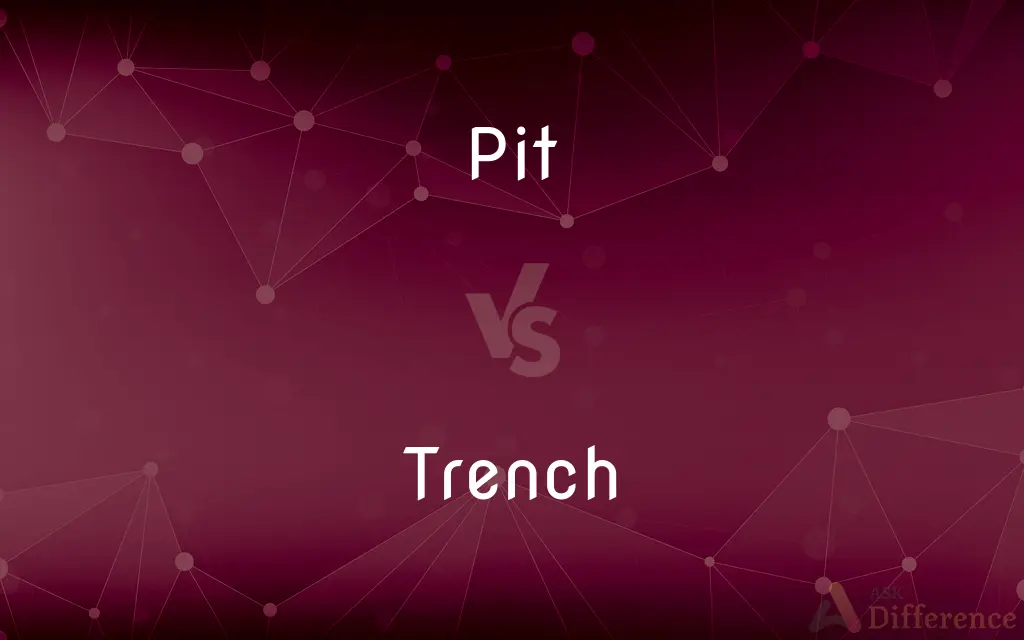Pit vs. Trench — What's the Difference?
By Maham Liaqat & Urooj Arif — Updated on March 2, 2024
A pit is typically a hole or cavity dug in the ground, often for a specific purpose like waste disposal or mining, while a trench is a long, narrow excavation, usually deeper than it is wide, made for defensive purposes, drainage, or laying pipes.

Difference Between Pit and Trench
Table of Contents
ADVERTISEMENT
Key Differences
Pits are generally understood to be more circular or irregular in shape, created for various reasons, including storage, hiding, or as traps. They can vary significantly in size and depth but are characterized by their enclosed nature, limiting their length and often their accessibility from only the top. Whereas trenches are elongated excavations that have a strategic, functional, or construction-related purpose, emphasizing their length over depth or width. Trenches are designed to be accessed or traversed along their length, serving as conduits, barriers, or positions for concealment or protection.
While a pit may be dug to store water, bury waste, or mine minerals, reflecting a wide range of uses across different contexts, a trench is more likely to be associated with specific functions such as irrigation, drainage, or as defensive positions in military contexts. The construction of trenches is often a more labor-intensive process due to their extended length and the need for structural integrity along their span, especially when used in warfare or for infrastructure projects like sewage systems or underground utilities.
The use of pits is ancient, with archaeological sites often identifying pits used for storage, habitation, or ceremonial purposes. In contrast, the strategic use of trenches has been well-documented in modern warfare, where they provide cover and movement lanes for troops, as well as in civil engineering for managing water flow or as conduits for pipes and cables.
Pits are usually isolated features unless part of a larger network, like pit latrines or mining operations. Trenches, by their nature, are often part of a system or network, connecting different points for functional purposes, such as in trench warfare where multiple trenches are interconnected for strategic defense, or in urban planning where trenches are used to lay and connect utility lines across distances.
Both pits and trenches are types of excavations, their purposes, shapes, and the methods used for their construction distinguish them from one another. Pits serve more as individual containers or holes, whereas trenches are part of larger networks or systems, designed for elongated functionality.
ADVERTISEMENT
Comparison Chart
Shape
Circular or irregular
Long and narrow
Purpose
Storage, disposal, mining
Defense, drainage, laying pipes
Depth vs. Width
Depth and width variable, often wider than deep
Usually deeper than wide, length emphasized
Usage Context
Archaeological, residential, industrial
Military, agricultural, civil engineering
Accessibility
Accessed from the top
Accessed along the length
Construction
Can be simple or complex, depending on purpose
Labor-intensive, requiring structural support
Functionality
Often isolated or part of a small network
Part of larger systems or networks
Compare with Definitions
Pit
Can be naturally occurring or man-made.
Natural pits formed by erosion versus pits dug for mining.
Trench
For strategic, functional, or construction purposes.
Agricultural trenches for irrigation.
Pit
Varies in size and depth.
Small pits for planting trees or large pits for construction foundations.
Trench
Part of a system or network.
Trench networks used in urban planning for utility connections.
Pit
Used for storage or disposal.
A pit used for composting organic waste.
Trench
Requires structural integrity along its span.
Trenches supported with shoring to prevent collapses during construction.
Pit
Specific purposes.
Pits used in archaeological sites for preservation or study.
Trench
A long, narrow ditch
Dig a trench around the perimeter of the fire
Pit
A large hole in the ground.
Trench
Deeper than it is wide, emphasizing length.
Trenches used in trench warfare for defense.
Pit
A hollow or indentation in a surface.
Trench
A trench is a type of excavation or depression in the ground that is generally deeper than it is wide (as opposed to a wider gully, or ditch), and narrow compared with its length (as opposed to a simple hole or pit).In geology, trenches result from erosion by rivers or by geological movement of tectonic plates. In civil engineering, trenches are often created to install underground utilities such as gas, water, power and communication lines.
Pit
An area at the side of a track where racing cars are serviced and refuelled
He had a flat tyre when he came into the pits
The pit lane
Trench
A long, narrow, deep depression in the ocean bed, typically one running parallel to a plate boundary and marking a subduction zone
The Marianas Trench
Pit
A trap in the form of a concealed hole
Trench
To dig or make a trench or trenches in (land or an area, for example).
Pit
Hole or cavity in the ground.
A pit dug for a bonfire.
Trench
Cut a trench in, as for drainage;
Ditch the land to drain it
Trench the fields
Trench
Dig a trench or trenches;
The National Guardsmen were sent out to trench
Trench
Long, narrow excavation.
Trenches dug for installing water pipes.
Common Curiosities
What is the main difference between a pit and a trench?
The main difference lies in their shape and purpose; pits are more for individual use, while trenches are part of a system or network.
Why are trenches used in warfare?
Trenches provide soldiers with cover from enemy fire and a secure position from which to defend or launch attacks.
What precautions are necessary when digging pits or trenches?
Safety measures include assessing soil stability, avoiding underground utilities, and, for trenches, ensuring structural support to prevent collapses.
What innovations have been made in the construction of pits and trenches?
Innovations include trenchless technology for installing pipes with minimal surface disruption and environmentally friendly pit latrines for sanitation.
How are pits and trenches constructed?
Both require excavation, but trenches often need structural support like shoring to prevent collapses, especially in soft soil or for deep excavations.
Can both pits and trenches occur naturally?
While pits can be natural or man-made, trenches are generally man-made, except for natural formations that resemble trenches, such as ravines.
How do pits and trenches impact ecosystems?
They can alter water flow, affect soil stability, and create new habitats or barriers for wildlife, requiring careful planning to mitigate negative impacts.
Can a pit become a trench if extended?
Technically, extending a pit could make it resemble a trench, but its purpose and construction method would also need to align with those of a trench.
How do environmental considerations affect the digging of pits and trenches?
Environmental considerations include preventing contamination of groundwater, avoiding disturbance of natural habitats, and ensuring proper drainage.
Can pits and trenches be repurposed after their initial use?
Yes, pits can be filled and repurposed for land development, while trenches can be reused for different utilities or filled to restore the land.
Share Your Discovery

Previous Comparison
Apex vs. Crest
Next Comparison
Companion vs. WifeAuthor Spotlight
Written by
Maham LiaqatCo-written by
Urooj ArifUrooj is a skilled content writer at Ask Difference, known for her exceptional ability to simplify complex topics into engaging and informative content. With a passion for research and a flair for clear, concise writing, she consistently delivers articles that resonate with our diverse audience.













































